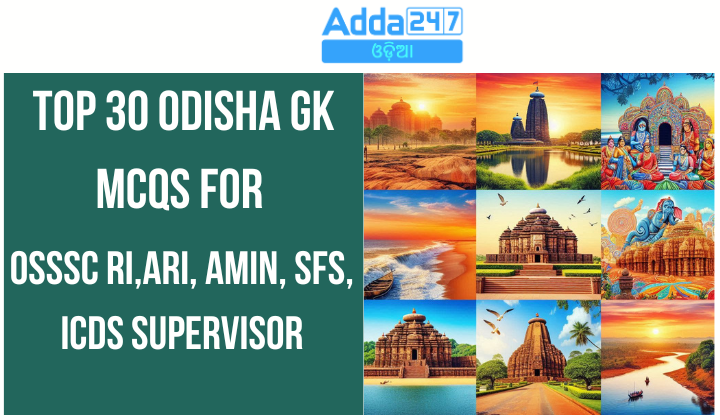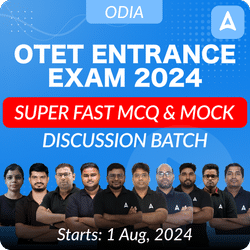General Knowledge is a crucial component of competitive exams, and when it comes to Odisha, a rich tapestry of history, culture, and geography awaits exploration. As you prepare for OSSSC RI, ARI, Amin, SFS, ICDS Supervisor exams, mastering Odisha GK is indispensable. This article presents a curated set of Top 30 Odisha General Knowledge Multiple-Choice Questions (MCQs) to sharpen your knowledge base and boost your exam readiness.
Top 30 Odisha GK MCQs for OSSSC RI,ARI, Amin, SFS, ICDS Supervisor
- Which circular directed the abolition of Odia as the court language of Sambalpur in 1895?
(a) Risley Circular
(b) Andrew Fraser Circular
(c) Curzon Circular
(d) None of the above
Answer: (b) Andrew Fraser Circular - Who founded the Utkal Sammilani in 1903 to ventilate the grievances of the Odia-speaking people?
(a) Madan Mohan Mishra
(b) Brajamohan Patnaik
(c) Mahant Bihari Das
(d) Madhusudan Das
Answer: (d) Madhusudan Das - Which organization played a significant role in restoring the nationalism of Odisha?
(a) Ganjam Jatiya Samity
(b) Utkal Sammilani
(c) Indian National Congress
(d) None of the above
Answer: (b) Utkal Sammilani - In which year was the Ganjam National Conference held, expressing the desire for a united Odisha?
(a) 1895
(b) 1903
(c) 1907
(d) 1911
Answer: (c) 1907 - Who criticized the creation of Bihar and Odisha in the House of Lords in February 1912?
(a) Madan Mohan Mishra
(b) Brajamohan Patnaik
(c) Lord Curzon
(d) Mahant Bihari Das
Answer: (c) Lord Curzon - When was the province of Bihar and Odisha inaugurated?
(a) 1901
(b) 1911
(c) 1912
(d) 1920
Answer: (c) 1912 - Which publication strongly denounced Telugu ascendancy over Ganjam and pleaded for the fulfillment of the Odia demand for ‘Odian Odisha’?
(a) Utkal Sammilani
(b) Asha
(c) Utkala Dipika
(d) None of the above
Answer: (b) Asha - What was the population growth rate of rural areas in Odisha as per Census 2011?
(a) 7.50%
(b) 11.8%
(c) 14.05%
(d) 23.32%
Answer: (b) 11.8% - Which district in Odisha had the highest population growth rate according to Census 2011?
(a) Jagatsinghpur
(b) Balangir
(c) Cuttack
(d) Puri
Answer: (b) Balangir (23.32%) - What was the population growth rate of Jagatsinghpur district in Odisha as per Census 2011?
(a) 7.50%
(b) 11.8%
(c) 14.05%
(d) 23.32%
Answer: (a) 7.50% - What is the total population density of Odisha as per Census 2011?
(a) 270 persons per sq km
(b) 800 persons per sq km
(c) 91 persons per sq km
(d) 979 persons per sq km
Answer: (a) 270 persons per sq km - Which district in Odisha has the highest population density?
(a) Khordha
(b) Kandhamal
(c) Rayagada
(d) Nayagarh
Answer: (a) Khordha - What is the sex ratio of Odisha as per Census 2011?
(a) 979 females per 1000 males
(b) 1051 females per 1000 males
(c) 915 females per 1000 males
(d) 987 females per 1000 males
Answer: (a) 979 females per 1000 males - Which district in Odisha has the highest sex ratio?
(a) Rayagada
(b) Khordha
(c) Nayagarh
(d) Kandhamal
Answer: (a) Rayagada - Which dynasty was the first to establish a strong empire in Odisha during the Medieval era?
(a) Gajapati Dynasty
(b) Bhoi Dynasty
(c) Ganga or Eastern Ganga Dynasty
(d) Karrani Dynasty
Answer: (c) Ganga or Eastern Ganga Dynasty - Which renowned temples were built by the Ganga rulers during their reign in Odisha?
(a) Sun Temple and Lingaraja Temple
(b) Meenakshi Temple and Brihadeeswarar Temple
(c) Konark Temple and Jagannath Temple
(d) Kailasanathar Temple and Hoysaleswara Temple
Answer: (c) Konark Temple and Jagannath Temple - Who established the Gajapati dynasty in Odisha?
(a) Emperor Kapilendra Deva
(b) Marathas
(c) Mughals
(d) Karrani Dynasty
Answer: (a) Emperor Kapilendra Deva - Which dynasty was the first Muslim empire in Odisha?
(a) Karrani Dynasty
(b) Gajapati Dynasty
(c) Bhoi Dynasty
(d) Marathas
Answer: (a) Karrani Dynasty - Who took over Odisha after the Karrani Dynasty, making it a part of their empire?
(a) Marathas
(b) British
(c) Mughals
(d) Naib Nazims of Bengal
Answer: (d) Naib Nazims of Bengal - Who was the founder of the Ganga dynasty?
(a) Anantavarman Vajrahasta V
(b) Chodagangadeva
(c) Konkani Varma
(d) Narasimhadeva I
Answer: (c) Konkani Varma - Which type of forest in Odisha is permanently marked for the production of timber or other forest produce, allowing grazing and cultivation?
(a) Reserved Forest
(b) Protected Forest
(c) Unclassed Forest
(d) None of the above
Answer: (a) Reserved Forest - What percentage of Odisha’s total forest area is constituted by Reserved Forests according to the India State of Forest Report, 2017?
(a) 58.90%
(b) 40.75%
(c) 0.35%
(d) None of the above
Answer: (a) 58.90% - Which type of forest in Odisha allows grazing and cultivation with minor restrictions?
(a) Reserved Forest
(b) Protected Forest
(c) Unclassed Forest
(d) None of the above
Answer: (b) Protected Forest - What is the percentage of Odisha’s total forest area constituted by Unclassed Forests according to the India State of Forest Report, 2017?
(a) 58.90%
(b) 40.75%
(c) 0.35%
(d) None of the above
Answer: (c) 0.35% - What is the literal meaning of the name “Mahakantara” found in some Gupta-era inscriptions?
(a) Great River
(b) Great Plain
(c) Great Forest
(d) Great Mountain
Answer: (c) Great Forest - Which ancient region might be associated with the modern-day Kalahandi and Jeypore region?
(a) Tosali
(b) Mahakantara
(c) Utkala
(d) Kongoda
Answer: (b) Mahakantara - Which ancient region is associated with the name “Kamala Mandala” in a 13th-century inscription?
(a) Ganjam
(b) Jajpur
(c) Kalahandi
(d) Koraput
Answer: (c) Kalahandi - Which region is also known as Dakshina Kosala and may include parts of modern-day Chhattisgarh and Western Odisha?
(a) Chedi
(b) Utkala
(c) Kongoda
(d) South Kosala
Answer: (d) South Kosala - What does “Trikalinga” refer to according to copper plate inscriptions found in Sonepur?
(a) A region in the northern part of Odisha
(b) A subdivision of Kalinga
(c) Three different Kalinga states (Kalinga, South Kosala, and Kangod(a)
(d) A region in the southern part of Odisha
Answer: (c) Three different Kalinga states (Kalinga, South Kosala, and Kangod(a) - What kind of fossils are known to be found in the coal fields of Mahanadi and Ib river basins?
(a) Dinosaur bones
(b) Megaspores from the Upper Permian
(c) Trilobites from the Ordovician
(d) Ammonites from the Jurassic
Answer: (b) Megaspores from the Upper Permian










